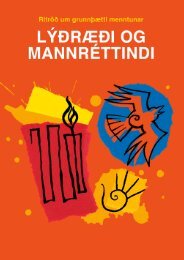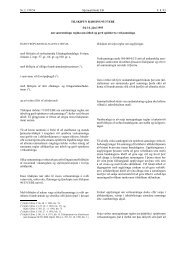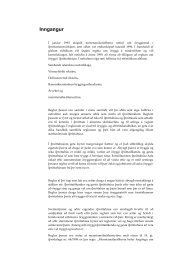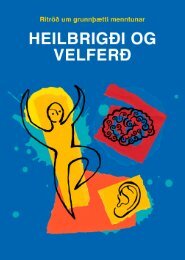Arts and Cultural Education in Iceland : Professor Anne Bamford
Arts and Cultural Education in Iceland : Professor Anne Bamford
Arts and Cultural Education in Iceland : Professor Anne Bamford
Create successful ePaper yourself
Turn your PDF publications into a flip-book with our unique Google optimized e-Paper software.
the museum. Similarly, schools see the museum as be<strong>in</strong>g a very marg<strong>in</strong>al resource with<strong>in</strong> their<br />
general curriculum. Additionally, the museums should be viewed as exist<strong>in</strong>g <strong>in</strong> the context of the<br />
broader arts <strong>and</strong> cultural education resources, <strong>in</strong>clud<strong>in</strong>g other after schools provisions. The size<br />
of the museum sector means that they often share collections. National cultural <strong>in</strong>stitutions are<br />
required to cooperate with schools <strong>and</strong> have developed projects to try <strong>and</strong> reach out to children<br />
<strong>and</strong> schools:<br />
The opera is a small company <strong>and</strong> does not have an education department. The Operastudio is a project where<br />
student <strong>in</strong>strumentalists <strong>and</strong> s<strong>in</strong>gers have a chance to participate <strong>in</strong> stag<strong>in</strong>g an opera <strong>and</strong> work with<br />
professionals. Periodically through the years an opera for children has been commissioned <strong>and</strong> staged <strong>in</strong> cooperation<br />
with a composer.<br />
The National Gallery of Icel<strong>and</strong> has about 40.000 guests annually <strong>and</strong> 8.000 young people. The Gallery is required<br />
by law to serve the schools. We cooperate with schools on exhibitions – teachers might call us with a specific<br />
agenda (e.g. for specific age group); there are theme days too. We tend to have the same teachers come aga<strong>in</strong><br />
<strong>and</strong> aga<strong>in</strong>. Visits are most common <strong>in</strong> 4-8 grades. We run a new education project related to each new exhibit.<br />
The follow<strong>in</strong>g two vignettes show the way arts organisations can work with schools to<br />
<strong>in</strong>troduce the children to wider experiences <strong>in</strong> the arts.<br />
Vignette 3.2.5 Schools pull me <strong>in</strong> with clawed sticks<br />
Schools pull me <strong>in</strong> with clawed sticks (artist). Real artists should be <strong>in</strong> schools. Schools should be more open. Teacher<br />
education is quite boxed. The schools don't have qualified people... Tóney is offer<strong>in</strong>g schools projects <strong>in</strong> music. This is<br />
the future <strong>and</strong> schools are open<strong>in</strong>g up for this. We can serve 4-5 schools <strong>in</strong> this manner. People were suspicious at<br />
first but now the co-operation is good. This is how film photography, etc. should be taught. That is way it is so<br />
important that artists be active <strong>in</strong> the educational system. Introduce to the kids, open doors, <strong>and</strong> then it's up to them<br />
to take th<strong>in</strong>gs up <strong>and</strong> do someth<strong>in</strong>g with them. We [Tóney] are teach<strong>in</strong>g <strong>in</strong> Fella neighbourhood [a less well off<br />
neighbourhood <strong>in</strong> Reykjavik], <strong>and</strong> also <strong>in</strong> Grafarholt [a newly developed neighbourhood]. Both of these areas will<br />
experience tough times <strong>in</strong> the com<strong>in</strong>g months [referr<strong>in</strong>g to the economic situation]. Our aim should be to create with<br />
the children, to make their m<strong>in</strong>ds occupied; make the school attractive to them, a nice place to be.<br />
Vignette 3.2.6 Maximus Musicus is an example of a recent successful project<br />
The Icel<strong>and</strong> Symphony Orchestra plays five concerts annually especially for children <strong>and</strong> three aimed at young people.<br />
About 10-15% of the workload goes towards young people. Most of the musicians are teachers, so to work with<br />
young people is natural to them. Maximus Musicus 17 is an example of a recent successful project. In a popular quiz<br />
competition among secondary school students, they usually do poorly on questions concern<strong>in</strong>g the arts. I'm<br />
frightened that education will suffer <strong>in</strong> the worsen<strong>in</strong>g economic climate. The Orchestra would like to do more<br />
collaboration especially with the music schools. We do a number of projects organized through Music for All where<br />
four musicians work with the kids for one week – compos<strong>in</strong>g. It would be great for the Orchestra to work more with<br />
schools. Icel<strong>and</strong> needs a youth orchestra. In Venezuela there is an <strong>in</strong>credibly successful programme where young<br />
people practice classical music. The project has created an amaz<strong>in</strong>g new culture. Children from outside of Reykjavik<br />
have to pay for the children’s' program – as Reykjavik supports the Symphony Orchestra f<strong>in</strong>ancially.<br />
The “Music for All” programme (described <strong>in</strong> vignette 3.2.6) has successfully bridged the gap<br />
between the educational <strong>and</strong> creative workforce by br<strong>in</strong>g<strong>in</strong>g professional musicians <strong>and</strong><br />
performances to schools <strong>and</strong> villages around Icel<strong>and</strong>. On average, schools would have 1-2 visits<br />
per year. While these encounters tended to be ‘one-off’ experiences where a performance or<br />
other arts group will come <strong>in</strong>to the school for a s<strong>in</strong>gle performance, they were widely<br />
remembered by children <strong>and</strong> commended by parents <strong>and</strong> teachers. At other times, local<br />
amateur theatre groups may visit a local community centre <strong>and</strong> perform a very short season<br />
(between 1 day <strong>and</strong> 5 days) <strong>in</strong> that venue, <strong>and</strong> local pupils would be brought to see the play by<br />
their school teachers. Once aga<strong>in</strong>, smaller more isolated communities tended to have stronger<br />
l<strong>in</strong>ks with teachers <strong>and</strong> pupils likely to have direct connections with the local amateur groups.<br />
These encounters between professional artists <strong>and</strong> schools seemed to be well-received by the<br />
schools:<br />
17 http://www.maximusmusicus.com<br />
58



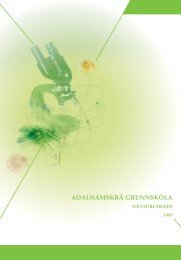
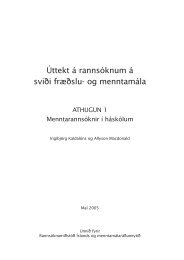

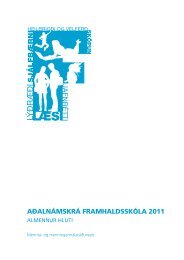
![Aðalnámskrá tónlistarskóla : rytmÃsk tónlist [Eingöngu á rafrænu formi]](https://img.yumpu.com/50843672/1/184x260/aaalnamskra-tanlistarskala-rytma-sk-tanlist-eingangu-a-rafranu-formi.jpg?quality=85)
